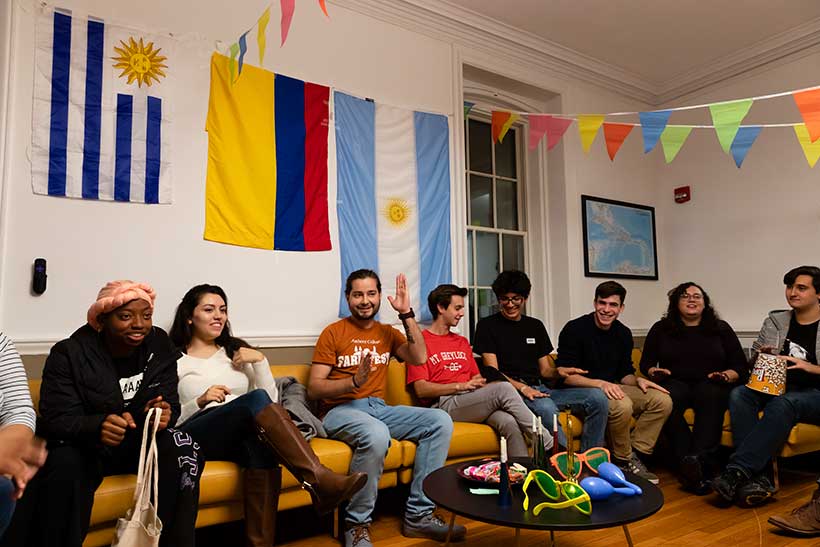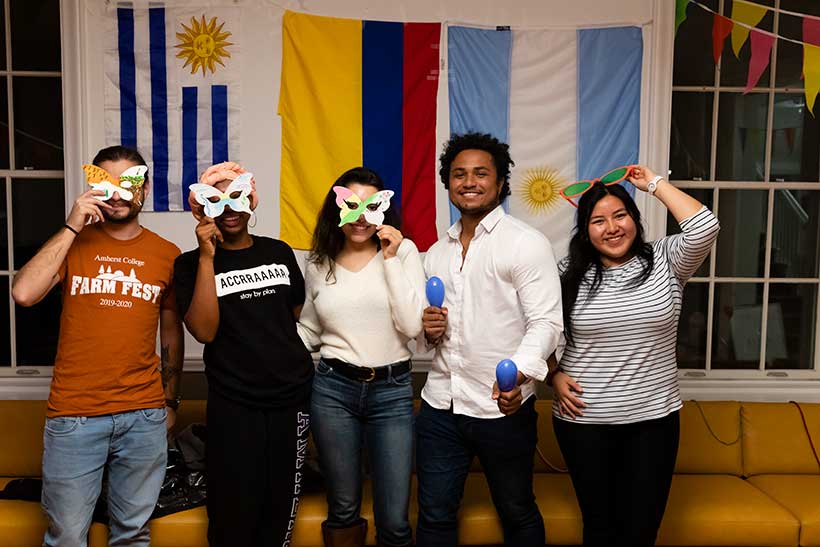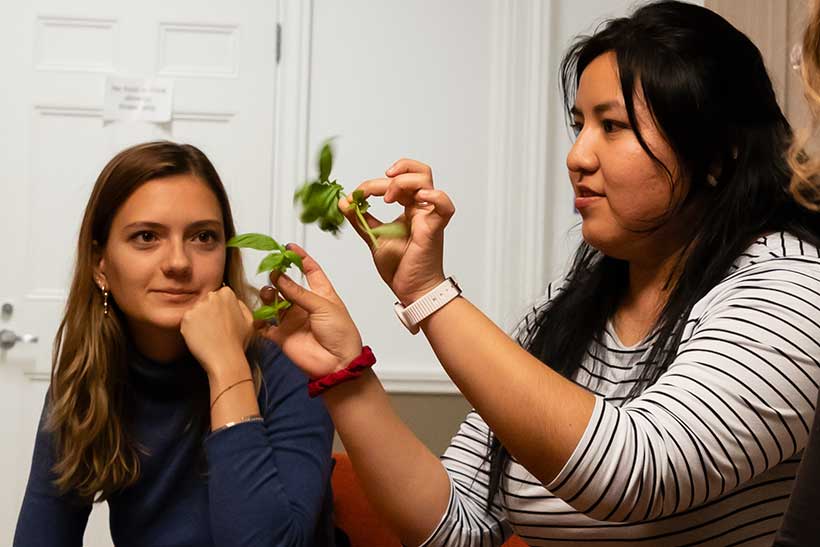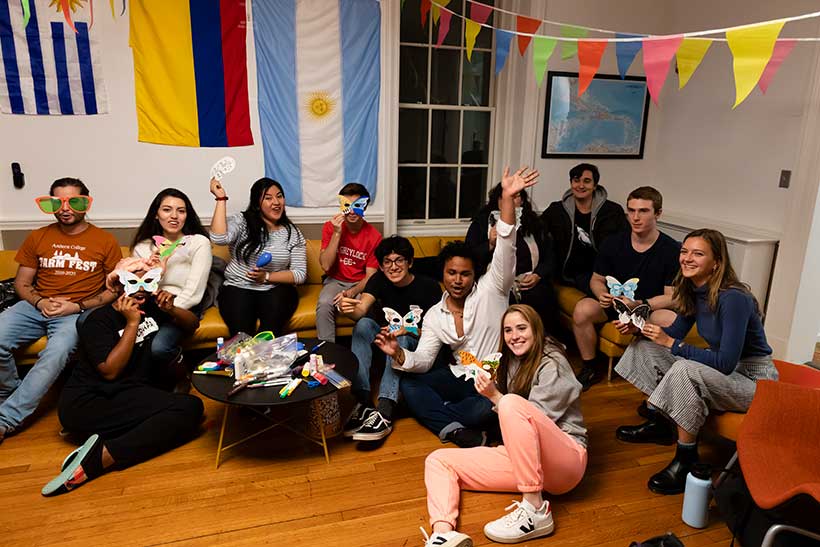“We are not shying away from the new,” says Paul Schroeder Rodríguez, chair of the Spanish department. “We are embracing it.”
He’s talking about the burgeoning changes—some in motion, others due to kick off in the Spring 2020 semester—in how Spanish is taught at Amherst. They cut to the heart of language instruction itself. They also reframe how the culture of Spanish-speaking peoples gets taught. (Preview: a greater emphasis on Latin American and US Latinx cultures.)

La Tertulia (in English, "the salon") is Amherst's gathering for Spanish language learners, held at Newport House. At this particular meeting, the subject was the festival traditions of the home countries of the three Fulbright Language Teaching Assistants at the College this year. Braulio Paz, a FLTA from Uruguay (with hands in the air) leads a drumming session.
Parallel alterations are playing out in the College’s other language departments, especially French. And all this is happening as American higher ed hits refresh on language pedagogy for today’s students.
The impact is greatest in Spanish because of the sheer numbers: it is the most studied language in the United States, with 50 percent of college students who take language classes choosing Spanish. French is a distant second, at 12 percent, followed by American Sign Language and German.
When it came to rethinking the major in 2016, the Spanish professors at Amherst looked to, among others, the German professors at Emory University, who began revamping their department in 2007 and wrote incisively about the process. Amherst also welcomed a team of Spanish scholars from Wellesley, Dartmouth, McGill and Boston University to do an external review and make recommendations for enhancing the way Spanish is taught at the College.

Fulbright Language Teaching Assistants Braulio Paz (in FarmFest shirt), Luis Pájaro Theran, of Colombia (with maracas) and Rocío Barboza, of Argentina (in striped shirt) lead the celebrations.
“It is no secret that collegiate foreign language education has been leading a bifurcated existence for decades,” the Emory study declares. The old bifurcation can be summed up as “language first, content second.” Students had to master the tongue to some degree before they could study the culture.
The new curricular thinking is bent on healing that division: now, you absorb the culture while you absorb the language, not after. Carmen C. Granda, lecturer in Spanish, recalls her own college Spanish classes: “The culture part was always done at the end of the week, on ‘Cultural Friday.’ You did intensive language and grammar all year, and you might squeeze in some culture. Now culture is in the curriculum every day. That’s the hook to grab students’ attention.”
Adds Sony Coráñez Bolton, assistant professor of Spanish, “Grammar is now the means to an end. It was frankly boring when we used to do it the other way around.”
When Amherst Spanish students learn food vocabulary, for instance, it might be centered on the cuisine and mealtime customs of Costa Rica or Chile. Even in the most introductory language courses, students will engage with poems, short stories and videos from Mexico, Spain, Panama—any of the world’s Spanish-speaking countries.

Rocío Barboza speaks with a student of the plant life of her native Argentina. As the Spanish department embraces changes in the way Spanish language and culture is taught, students are getting more and more opportunities for informal interactions and language immersion.
Language learning will also be animated by the department’s new textbook of choice, Contraseña: Your Password to Foundational Spanish 2.0, which offers exercises, projects and real-time feedback. “It’s a digital textbook and is based on this cultural approach,” explains Jeannette Sánchez-Naranjo, assistant professor of Spanish. “We selected it mainly because the authors are applied-linguistics researchers, and they are experts on how gaining a second language works.” Adds Schroeder Rodriguez, “It is cutting-edge.”
Moreover, this textbook links to a service called LinguaMeeting. It facilitates conversation practice with native speakers around the globe. Students tackling Spanish at Amherst, for instance, can Skype with students from Managua to Montevideo and beyond, choosing fresh locales and conversationalists each week.
Amherst has added another face-to-face way to go over the language: for each of the last several years, the College has hosted a handful of Fulbright Language Teaching Assistants (FTLAs), who take classes on American culture here, teach Amherst students and, in the case of the Spanish department, oversee the weekly Spanish Table at Valentine Dining Hall. This year’s three FTLAs teaching Spanish come from Argentina, Colombia and Uruguay. Says Sánchez-Naranjo, “They are very committed to showing the culture from their country, are closer to students’ age than professors are and contribute a lot to the program.”
Spanish has the second-largest number of native speakers in the world (after Mandarin Chinese), and there are more Spanish speakers in the U.S. than in Spain. At Amherst, 14 percent of students identify as Hispanic/Latinx, and many of them are heritage learners of Spanish, with a wide array of language proficiencies and identities. Sánchez-Naranjo teaches a class called “Owning the Bilingual Self,” which has generated a lot of buzz. “It’s a very empowering class for Latinx students here,” she says.
Changes are afoot in study abroad as well. “We used to say we encouraged our students to study abroad. Now we expect them to do so,” says Schroeder Rodríguez, noting that immersion is crucial to advancing in the language. Students from different courses are also heading overseas together, such as those enrolled in “Camino de Santiago,” which focuses on the historic pilgrimage to the Cathedral of Santiago de Compostela in Galicia, Spain, and those in “Puerto Rico: Diaspora Nation.”

Group shot, with festive props. La Tertulia is held every Thursday at the first floor common room at Newport House. It is free and open to anyone, students of all levels, faculty, staff and community members. The only requirement: Speaking Spanish and having a good time!
A “Reimaging the Commons” grant from the Andrew W. Mellon Foundation enabled the evaluation process in the Spanish department. Other departments that have undergone similar processes or are about to follow suit include geology, economics, math and statistics, as well as law, jurisprudence and social thought.
Meanwhile, Amherst’s other language departments are exploring their own modifications. The French department is including more works for analysis by Francophone authors, thinkers and artists outside of France; has updated their video teaching sources (as in Spanish, they’re also culturally linked); and has added studies of contemporary social movements (such as France’s “Yellow Jacket” protests).
The German department is looking into revamping its introductory language course by adopting a more topical (and less expensive) textbook. And, in Spring 2019, the Russian department introduced a Capstone Project for majors that involves selecting and studying an artifact from one of the collections in the Amherst Center for Russian Culture.
“Si Adelante no vas, atrasarás,” as the saying goes. “He who does not advance goes backward.”